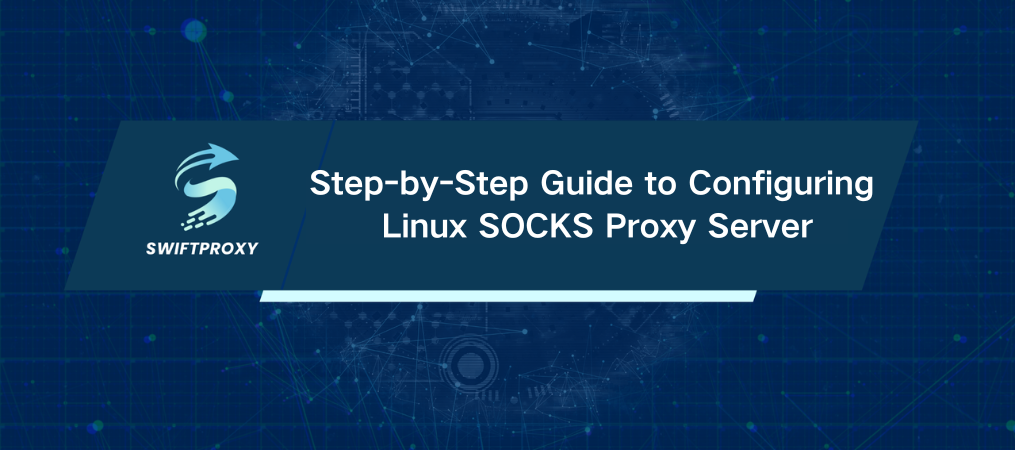Step-by-Step Guide to Configuring Linux SOCKS Proxy Server

In today's hyper-connected world, online privacy and security are more important than ever. One of the most effective ways to safeguard both is by using a SOCKS5 proxy server on your Linux system. By routing your internet traffic through a remote server, a SOCKS5 proxy not only hides your IP address but also encrypts your data, ensuring your browsing remains private and secure. Ready to take control of your online security? Let's dive into how to configure a SOCKS5 proxy server on Linux.
Why Use a SOCKS5 Proxy Server on Linux
A SOCKS5 proxy is a powerful tool for managing your internet traffic. Unlike HTTP proxies, which only work for web traffic, SOCKS5 supports all types of internet traffic—including TCP, UDP, and more. This makes it versatile and perfect for applications like streaming, gaming, or even torrenting, where a stable and secure connection is a must.
By setting up a Linux SOCKS proxy server, you can:
Hide your IP address: Maintain anonymity while surfing the web.
Bypass geo-restrictions: Access websites and content that are blocked in certain regions.
Secure your data: Protect sensitive information from hackers and spies.
With these benefits in mind, setting up a SOCKS5 proxy on Linux can significantly enhance your privacy and security online. Let's begin.
What You'll Need
Before we jump into the technical details, make sure you have the following:
A Linux server (Ubuntu, CentOS, or any other distribution).
Root or sudo access to install and configure software.
Basic familiarity with command-line operations.
Ready? Let's go.
Step 1: Install Necessary Software
To set up your SOCKS5 proxy server on Linux, we'll use Dante—a reliable and easy-to-configure software package for this purpose. Here's how to install it.
1. Upgrade your system:
Open a terminal and run:
bash
sudo apt update
sudo apt upgrade
2. Set up Dante:
Dante is the software we’ll use to power your SOCKS5 proxy:
bash
sudo apt install dante-server
Step 2: Set Up Your SOCKS5 Proxy Server
Now that Dante is installed, let’s configure your SOCKS5 proxy server to make sure it functions properly.
1. Modify the configuration file:
Open the configuration file in your preferred text editor:
bash
sudo nano /etc/danted.conf
2. Add the following configuration:
This simple setup will allow your proxy server to start routing traffic:
bash
logoutput: /var/log/danted.log
internal: eth0 port = 1080
external: eth0
method: username none
user.privileged: root
user.unprivileged: nobody
client pass {
from: 0.0.0.0/0 to: 0.0.0.0/0
log: connect disconnect
}
socks pass {
from: 0.0.0.0/0 to: 0.0.0.0/0
log: connect disconnect
}
What this configuration does:
\`logoutput\`: Directs logs to a file for monitoring.
\`internal\`: Sets the internal network interface (e.g., \`eth0\`) and port (1080).
\`external\`: Specifies the external network interface.
\`method\`: No authentication for simplicity (you can secure it later).
\`user.privileged\` & \`user.unprivileged\`: Define which users the server runs as.
3. Save and Exit
Save and exit the editor by pressing \`Ctrl + X\`, then \`Y\`, and hit \`Enter\`.
Step 3: Launch Your SOCKS5 Proxy Server
It's time to start your SOCKS5 proxy server and make it active.
1. Launch the Dante service:
Run this command to launch the service:
bash
sudo systemctl start danted
2. Set Dante to start on boot:
Ensure the server automatically starts on reboot:
bash
sudo systemctl enable danted
3. Verify the service status:
Confirm that your SOCKS5 proxy server is running smoothly:
bash
sudo systemctl status danted
Step 4: Verify Your SOCKS5 Proxy Server
You want to make sure your Linux SOCKS proxy server is working properly, so let’s test it.
1. Set up curl (if it’s not installed already):
bash
sudo apt install curl
2. Test connection:
Use the following curl command to see if the proxy is functioning:
bash
curl --socks5 localhost:1080 http://example.com
If everything is set up correctly, you should see the HTML content from the website. This confirms that your SOCKS5 proxy is working.
Step 5: Adjust Firewall Settings
If you're running a firewall on your Linux system, you’ll need to allow traffic through the SOCKS5 proxy's port (default is 1080).
1. Allow port 1080 through the firewall:
If you're using UFW, run this command:
bash
sudo ufw allow 1080/tcp
2. Reload the firewall:
Apply the new firewall rules:
bash
sudo ufw reload
Conclusion
You have successfully set up a SOCKS5 proxy server on your Linux machine. With this proxy in place, you can browse the web securely, access restricted content, and maintain your privacy online.
For added security, consider enabling user authentication, logging activity, or monitoring traffic to ensure everything is running smoothly. You now have the tools to take control of your internet privacy and can use them effectively.
Enjoy the benefits of an anonymous and secure browsing experience, all thanks to your new SOCKS5 proxy server on Linux.

















































